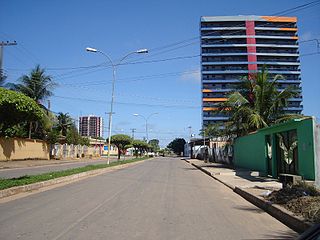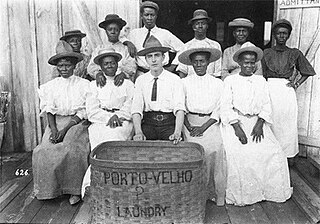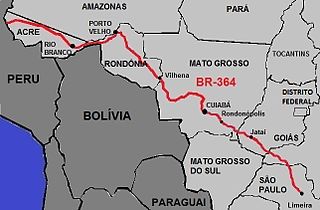Related Research Articles

Rondônia is one of the 26 states of Brazil, located in the northern subdivision of the country. To the west is a short border with the state of Acre, to the north is the state of Amazonas, in the east is Mato Grosso, and in the south and southwest is Bolivia. Rondônia has a population of 1,815,000 as of 2021. It is the fifth least populated state. Its capital and largest city is Porto Velho. The state was named after Cândido Rondon, who explored the north of the country during the 1910s. The state, which is home to 0.8% of the Brazilian population, is responsible for 0.6% of the Brazilian GDP.

Ji-Paraná is the second most populous municipality in the Brazilian state of Rondônia, with a population of 130,009, and the 16th most populous city of the Brazilian North Region, the 210th most populous city of Brazil, and the 113th of the Brazilian interior. It has an area of 6,897 km2. The city is divided by the Ji-Paraná River.

Porto Velho is the capital of the Brazilian state of Rondônia, in the upper Amazon River basin, and a Catholic Metropolitan Archbishopric. The population is 548,952 people. Located on the border of Rondônia and the state of Amazonas, the town is an important trading center for cassiterite, the mining of which represents the most important economic activity in the region, as well as a transportation and communication center. It is on the eastern shore of the Madeira River, one of the main tributaries of the Amazon River. It is also Rondônia's largest city, and the largest state capital of Brazil by area.

The Chapacuran languages are a nearly extinct Native American language family of South America. Almost all Chapacuran languages are extinct, and the four that are extant are moribund. They are spoken in Rondônia in the southern Amazon Basin of Brazil and in northern Bolivia.
Paraná, Paranã or Parana may refer to:
Karipuna or Caripuná may refer to:
Aikanã is an endangered language isolate spoken by about 200 Aikanã people in Rondônia, Brazil. It is morphologically complex and has SOV word order. Aikanã uses the Latin script. The people live with speakers of Koaia (Kwaza).
The Monde languages of Brazil form a branch of the Tupian language family.

Caribbean Brazilians refers to Brazilians of full, partial, or predominantly Caribbean ancestry, or Caribbean-born people residing in Brazil. Many Caribbean Brazilians are of Barbadian descent.
The Capitão Cardoso River is a river forming part of the border between Rondônia and Mato Grosso states in western Brazil. It is a tributary of the Roosevelt River.

The Jamari River is a river of Rondônia state in western Brazil.

The Ji-Paraná River, sometimes spelled Jiparaná, is a river in Rondônia state in western Brazil. It is a tributary of the Madeira River in the Amazon Basin. For much of its length it runs roughly parallel with the northeastern state border of Rondônia. The city of Ji-Paraná is divided by the river.
The Arikem languages of Brazil form a branch of the Tupian language family.
Arara may refer to:
Warázu, also known as Pauserna or Guarasugwé (Guarasú'we), is a moribund Tupi–Guaraní language of Brazil. It was also formerly spoken in Bolivia. It is spoken by the Guarasugwé people, who were estimated to number 125 according to a census in 2012.

Principe da Beira is a fortification on the lower part of the Guaporé River close to its confluence with the Mamoré River in the Brazilian state of Rondônia.
The Traçadal Biological Reserve is a biological reserve in the state of Rondônia, Brazil.

BR-364 is an inter-state highway in Brazil connecting the southeast state of São Paulo to the western state of Acre. The highway was opened in the 1960s and paved in the 1980s. It has brought economic development and population growth in the Amazon basin states of Rondônia and Acre. It has also caused massive environmental damage and socio-economic impacts. The road is extremely important for the flow of agricultural and livestock production in the states of Rondônia, Mato Grosso and Goiás, for Brazilian domestic consumption and for export, mainly by Port of Santos.
The Rio Ouro Preto Biological Reserve is a biological reserve in the state of Rondônia, Brazil.